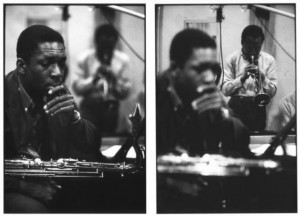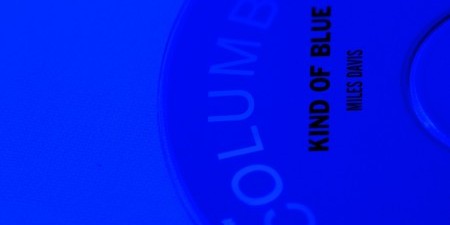 I’ve been wrestling with the next selection in my Seminal Works series. I knew I wanted to write about an album, but when I thought of the album I have listened to the most, I was a little embarrassed. I’ve listened to this album over and over again, sometimes for days and days on end, but I wasn’t sure how to write about it. A universally recognized jazz masterpiece and, by some accounts, the best-selling jazz album of all time, saying you love Miles Davis’ Kind of Blue is like saying Sgt. Pepper’s Lonely Hearts Club Band is a great and hugely influential album. It is just so obvious. If you listen to jazz, you’ve probably got it in your collection, if you don’t listen to jazz, there is a good chance you’ve heard of Kind of Blue or it may be the one jazz album you own. It is the only CD I’ve bought three copies of over the last 16 years — one because I had actually managed to wear a CD out, another because I had impulsively given my copy away to a friend who I was sure had to have it in their collection and then another because I needed to have the digitally remastered reissue. As rapper Q-Tip says on a documentary included in the 50th-anniversary DVD/ double-CD set released last year, “It’s like the Bible– you just have one in your house.”
I’ve been wrestling with the next selection in my Seminal Works series. I knew I wanted to write about an album, but when I thought of the album I have listened to the most, I was a little embarrassed. I’ve listened to this album over and over again, sometimes for days and days on end, but I wasn’t sure how to write about it. A universally recognized jazz masterpiece and, by some accounts, the best-selling jazz album of all time, saying you love Miles Davis’ Kind of Blue is like saying Sgt. Pepper’s Lonely Hearts Club Band is a great and hugely influential album. It is just so obvious. If you listen to jazz, you’ve probably got it in your collection, if you don’t listen to jazz, there is a good chance you’ve heard of Kind of Blue or it may be the one jazz album you own. It is the only CD I’ve bought three copies of over the last 16 years — one because I had actually managed to wear a CD out, another because I had impulsively given my copy away to a friend who I was sure had to have it in their collection and then another because I needed to have the digitally remastered reissue. As rapper Q-Tip says on a documentary included in the 50th-anniversary DVD/ double-CD set released last year, “It’s like the Bible– you just have one in your house.”
In fact, the accolades the album has received and continues to receive might make it seem a little boring, the equivalent of musical broccoli. Kind of Blue is deceptively accessible and melodic, its understatement belies the remarkable innovation of the seven now-legendary musicians that played on the album: tenor saxophonist John Coltrane, alto saxophonist Julian “Cannonball” Adderley, pianists Bill Evans and Wynton Kelly, bassist Paul Chambers, drummer Jimmy Cobb and, of course, trumpeter Miles Davis. However, sometimes hype is justified, Kind of Blue earns it reputation with every listen.
The album was recorded in two sessions in 1959. Even before Kind of Blue, Davis was experimenting with “modal” jazz, keeping the background of a tune simple while soloists played a melody over one or two modes, or scales, instead of busy set chord progressions – the usual harmonic foundation of jazz.With Evans, Davis worked up a few basic compositional sketches, and when the musicians arrived at the studio on March 2, 1959, they were given the outlines. Davis wanted to capture the musicians’ spontaneity.
The result is an album with extraordinary freedom and ease of movement. It captures the beauty and energy of live performance, the hair-standing-up-on-the-back-of-your-neck electricity that is usually generated by the relationship between performer and audience and is so rarely caught on tape. The music wanders through a huge range of emotion from meditative and poignant to joyful and playful, all within a few moments. However, the listener never feels lost, the wandering quality is anchored by the simplicity of the background tune.
I always find a new bottom to the album, something I hadn’t recognized before. I got my first copy when I was 17, I didn’t really know much about the album or jazz, but I had read somewhere that it was supposed to be good. At the time, I was self-conscious, eager to seem sophisticated and grown-up to the older boy I had a crush on who worked at Flipside Records — the independent record store I haunted as a teenager. The record got under my skin within two listens, making me forget my crush and every other album I owned for awhile.
The recording has stayed with me, affirming my good moods and sitting with me while I brooded over boys and papers for school. Later, the music soothed me through late-night feedings with my babies, eased me through mundane daily chores, the cool walkabout of “So What” making dish-doing and bathroom cleaning seem less oppressive. “All Blues” talked to me in the quiet late-night hours when I’d stayed up working on a deadline or found myself unable to sleep. I’ve listened to Kind of Blue so much that it a part of my interior landscape, at once familiar and comforting, but still — miraculous after so many listens — exciting.
This post is the second in an on-going series about my essential albums, books, writers and musicians.
For more information on Kind of Blue and to listen to three of the album’s tracks, go here.

I waited an embarrassingly long time before I listened to Kind of Blue. I was dating my then-boyfriend R (who is now my jazz-loving and -playing hubby). Kind of Blue is amazing. I also have found that with each listen I hear something new. And you’re right, it DOES capture that electricity of live performance that is rarely caught on a recording. Fascinating.
That tears it. I am now going to check this out of the library and give it the full listen I know I always should have given it.
Cool. Return and report.
Heidi, this album will forever make me think of you! I do own it in my collection, one of only a couple of jazz CDs, and I love the memories associated with it. :)
Just a little embarrassed to say that everything I know about Miles Davis and John Coltrane I learned from Jerry Maguire.
Haha! I don’t remember talk of jazz in Jerry Maguire. What did you learn?
Dorothy’s “au pair” had a serious thing for jazz. He gave Jerry a mix tape of Miles Davis and John Coltrane which then became the comic relief for their love scene. They put the tape on (as Jerry had been instructed by the au pair to do) and proceed. A few minutes later, Jerry jumps up, exclaiming: “what is this!?!”
Also, maybe the album choice is not as obvious as I thought. The imaginary jazz critics in my head might have led me astray. :)